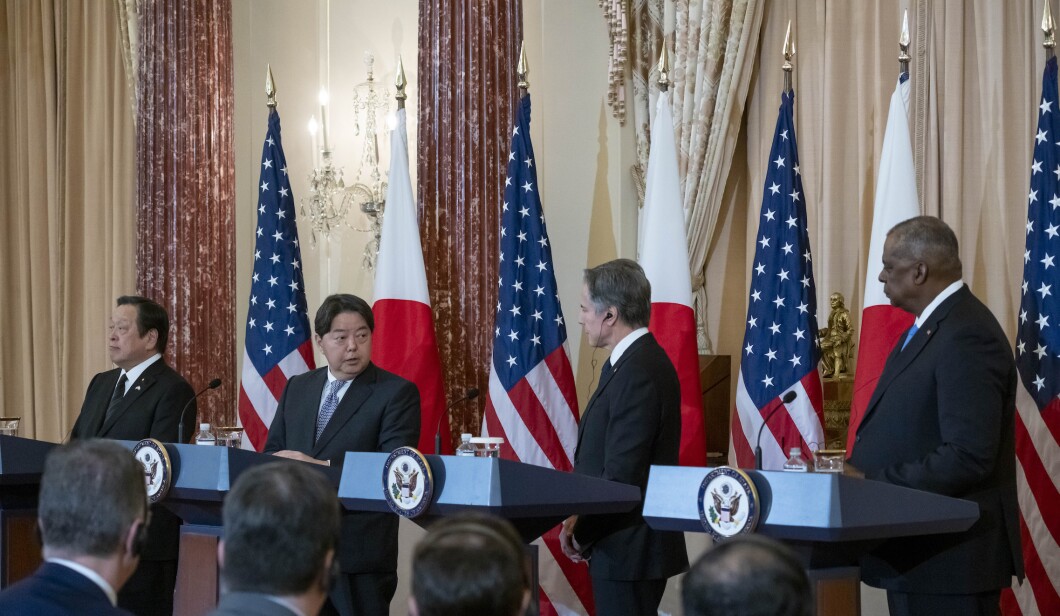
A reorganized U.S. Marine Corps regiment in Japan will be equipped with “long-range fires” by 2025, U.S. and Japanese officials announced, as the allies overhaul their defenses against China.
“We’re replacing an artillery regiment with an outfit that’s more lethal, more agile, more capable,” Defense Secretary Lloyd Austin told reporters during a joint press conference at the State Department. “It consists of a combat element, which is a battalion-sized element, a long-range fires element, which gives us an anti-ship capability … and also a logistical element that helps sustain the overall regiment there.”
Austin touted that “very, very important” capability alongside Secretary of State Antony Blinken and their Japanese counterparts, who affirmed Japanese Prime Minister Fumio Kishida’s determination to play a substantial role in managing the “increasingly severe security environment.” And those new Japanese initiatives, the U.S. officials emphasized, will unfold under the cover of the U.S. nuclear umbrella.
“We’re working to deepen our cooperation across every ground — land, sea, air, and yes, space — cyber and outer,” Blinken said. “The outer space component of this is an important [part of the] security and prosperity of our alliance. We agreed, as you’ve heard, that attacks to, from, or within space present a clear challenge. And we affirmed that depending on the nature of those attacks, this could lead to the invocation of Article V of our Japan-U.S. security treaty.”
JAPAN TO RAMP UP DEFENSE CAPABILITIES OVER NEXT FIVE YEARS AS THREATS GATHER
Austin put a finer point on that message to China in a pledge to defend Japan’s claim to the Senkaku Islands, uninhabited and disputed islands in the East China Sea between Okinawa, which hosts the bulk of the U.S. Marine contingent in Japan, and Taiwan, the island democracy that many strategists regard as the linchpin of the balance of power in the Indo-Pacific. China claims Taiwan and the Senkakus as its own territory, an assertion of sovereignty that could put the nuclear-armed communist regime on a collision course with Tokyo and Washington.
“Japan and the United States remain united in our concern over China’s destabilizing actions,” Austin said. “And I want to reaffirm the United States’s ironclad commitment to defend Japan with the full range of capabilities, including nuclear, and underscore that Article V of the mutual security treaty applies to the Senkaku Islands.”

The prospect of a Chinese invasion of Taiwan has haunted U.S. and Japanese officials in recent years as Chinese General Secretary Xi Jinping has conducted a significant military modernization effort and signaled his determination to bring Taipei under the communist regime’s control eventually. Those anxieties have been heightened by Russian President Vladimir Putin’s nuclear saber-rattling during the war in Ukraine, a tactic Kishida fears could be taken as a model for a nuclear-armed state to launch an invasion while deterring a U.S. intervention.
“The national security and defense strategies of our two countries that have been prepared most recently are highly consistent at a degree never seen before and will serve as a strong infrastructure for our bilateral cooperation,” Japanese Defense Minister Yasukazu Hamada said during the press conference. “What is noteworthy is the importance attached by both countries to integrate all means and approaches to deter a situation from occurring.”
The incoming “long-range fires” could help mitigate a vulnerability that has formed in recent years as Beijing has stockpiled thousands of land-based missiles designed to target major U.S. bases in the region and threaten U.S. warships that sail within their extensive range.
“This is designed to address the need for more anti-ship missiles in the vicinity of the Taiwan Strait,” American Enterprise Institute senior fellow Zack Cooper told the Washington Examiner. “It won’t solve the problem, but it will be much harder for China to target a dynamic force like this one, which will bolster resilience.”
The overhaul reflects a consensus that the U.S.-Japan alliance faces “a severely contested environment,” as a joint statement released after the quartet’s press conference put it, which the allies must hasten to address. Blinken saluted Kishida’s administration for promising “to double defense spending by 2027” — a loaded target date given that some U.S. officials and policymakers regard it as China’s “target date for taking Taiwan,” as Rep. Mike Gallagher (R-WI) put it recently — and his Japanese guests emphasized that they will put those plans “into action” with all deliberate speed.
CLICK HERE TO READ MORE FROM THE WASHINGTON EXAMINER
“Strategies don’t end by just preparing them,” Hamada said through an interpreter. “In light of the severity of the security environment, both Japan and the U.S. [are] expected to put their strategies into action swiftly and steadily. Based on the new strategy in order to expeditiously achieve the fundamental reinforcement of Japan’s defense capabilities, I am committed to making maximum efforts to gain new capabilities, including counterstrike capability.”





